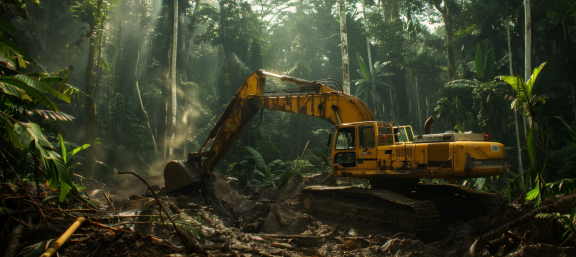Biodiversity, the variety of life in all its forms, is essential for the health and stability of ecosystems around the world. It provides critical services, from clean air and water to pollination of crops, climate regulation, and disease control. However, biodiversity is under severe threat due to human activities, leading to a crisis that has far-reaching implications for both natural systems and human societies. Stephen Wentzel of Zimbabwe delves into the primary causes of biodiversity loss, its consequences, and some potential solutions to address this urgent issue.
Causes of Biodiversity Loss
- Habitat Destruction
The most significant driver of biodiversity loss is habitat destruction. This occurs when natural environments are altered or completely eradicated by human activities such as agriculture, urban development, and logging. Forests, wetlands, and grasslands are often cleared to make way for farms, roads, and cities, leaving many species without the resources they need to survive.
- Climate Change
Climate change, driven by the burning of fossil fuels and deforestation, is altering temperature and precipitation patterns worldwide. These changes can disrupt the delicate balance of ecosystems, forcing species to migrate, adapt, or face extinction. Polar bears, coral reefs, and numerous plant species are among the many affected by rising temperatures and shifting climate zones.
- Pollution
Pollution, in its many forms, has proven to be a major threat to biodiversity. Chemicals from agricultural runoff, industrial discharges, and plastic waste can contaminate water, soil, and air, harming or killing plants and animals. Marine life, in particular, suffers from plastic pollution, which leads to ingestion, entanglement, and habitat degradation.
- Overexploitation
Overexploitation of natural resources, such as overfishing, hunting, and logging, depletes populations faster than they can recover. This not only reduces the number of individuals within a species but can also lead to the collapse of entire ecosystems. The Atlantic cod and numerous shark species are prime examples of overexploited populations.
- Invasive Species
The introduction of non-native species to new environments, either accidentally or intentionally, can have devastating effects on local biodiversity. Invasive species often outcompete, prey on, or bring foreign diseases to native species, leading to declines or even extinctions. Notable examples include the cane toad in Australia and the zebra mussel in North America.
Consequences of Biodiversity Loss
- Ecosystem Services Decline
Biodiversity underpins ecosystem services that are vital for human survival. The loss of species can impair functions such as pollination, water purification, and soil fertility, which are essential for agriculture and clean drinking water. As biodiversity declines, these services become less reliable, impacting food security and human health.
- Economic Impact
Biodiversity loss can have significant economic consequences. Many industries, including agriculture, fisheries, and tourism, depend on healthy ecosystems. The decline in fish stocks, such as from overfishing, can lead to loss of livelihoods for millions of people. Similarly, ecotourism, which generates substantial revenue, is directly threatened by the degradation of natural habitats.
- Health Risks
The loss of biodiversity can increase health risks for humans. Reduced biodiversity can lead to the proliferation of pests and diseases, as natural predators and competitors decline. Additionally, the destruction of natural habitats often brings humans into closer contact with wildlife, increasing the risk of zoonotic diseases, such as COVID-19, which originate in animals and can be transmitted to humans.
- Climate Regulation
Forests and oceans play a crucial role in regulating the Earth’s climate by absorbing carbon dioxide. Biodiversity loss in these ecosystems can undermine their ability to sequester carbon, exacerbating climate change. For instance, deforestation reduces the number of trees available to absorb CO2, while the decline of marine phytoplankton affects oceanic carbon storage.
Solutions to Biodiversity Loss
- Protected Areas
Establishing and effectively managing protected areas, such as national parks and marine reserves, can provide safe havens for biodiversity. These areas can help conserve critical habitats, allowing species to thrive and ecosystems to function properly. Expanding protected areas and ensuring they are adequately funded and enforced is paramount.
- Sustainable Practices
Adopting sustainable agricultural, fishing, and forestry practices can help reduce the impact on biodiversity. This includes techniques like agroforestry, no-till farming, and selective logging, which minimize habitat destruction and maintain ecosystem health. Sustainable practices can ensure that natural resources are used in a way that does not compromise future generations.
- Pollution Control
Reducing pollution through stricter regulations and innovative technologies can protect biodiversity. Efforts to minimize plastic waste, reduce pesticide use, and control industrial emissions are crucial. Clean-up initiatives, such as removing plastic from oceans and restoring polluted habitats, can also mitigate damage.
- Climate Action
Addressing climate change is vital for protecting biodiversity. This involves reducing greenhouse gas emissions through renewable energy, energy efficiency, and reforestation. Additionally, protecting and restoring ecosystems that act as carbon sinks, like forests and wetlands, can enhance their ability to absorb CO2 and mitigate climate change impacts.
- Invasive Species Management
Preventing the introduction of invasive species and controlling their spread is essential for protecting native biodiversity. This can be achieved through stricter biosecurity measures, public awareness campaigns, and targeted eradication programs. Restoring native habitats and species can also help ecosystems recover from invasive species damage.
Biodiversity loss is a complex and pressing issue that requires immediate and coordinated action. By gaining an understanding of the causes and consequences of this crisis, and implementing effective solutions, we can work towards preserving the rich tapestry of life on Earth. Protecting biodiversity is not only crucial for the health of ecosystems but also for the well-being and survival of humanity.
